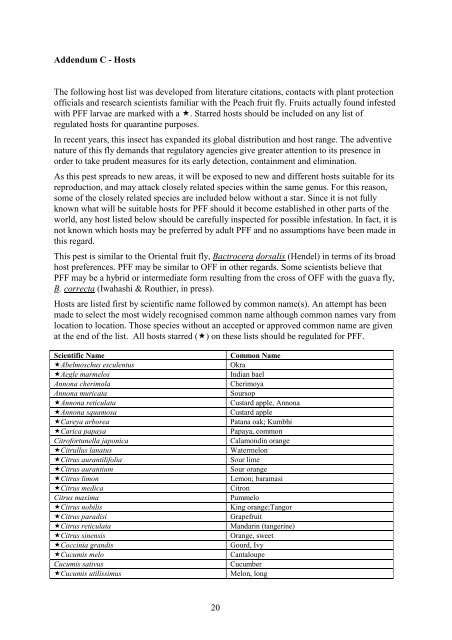Action Plan Peach Fruit Fly Bactrocera zonata - Nuclear Sciences ...
Action Plan Peach Fruit Fly Bactrocera zonata - Nuclear Sciences ...
Action Plan Peach Fruit Fly Bactrocera zonata - Nuclear Sciences ...
Create successful ePaper yourself
Turn your PDF publications into a flip-book with our unique Google optimized e-Paper software.
Addendum C - Hosts<br />
The following host list was developed from literature citations, contacts with plant protection<br />
officials and research scientists familiar with the <strong>Peach</strong> fruit fly. <strong>Fruit</strong>s actually found infested<br />
with PFF larvae are marked with a . Starred hosts should be included on any list of<br />
regulated hosts for quarantine purposes.<br />
In recent years, this insect has expanded its global distribution and host range. The adventive<br />
nature of this fly demands that regulatory agencies give greater attention to its presence in<br />
order to take prudent measures for its early detection, containment and elimination.<br />
As this pest spreads to new areas, it will be exposed to new and different hosts suitable for its<br />
reproduction, and may attack closely related species within the same genus. For this reason,<br />
some of the closely related species are included below without a star. Since it is not fully<br />
known what will be suitable hosts for PFF should it become established in other parts of the<br />
world, any host listed below should be carefully inspected for possible infestation. In fact, it is<br />
not known which hosts may be preferred by adult PFF and no assumptions have been made in<br />
this regard.<br />
This pest is similar to the Oriental fruit fly, <strong>Bactrocera</strong> dorsalis (Hendel) in terms of its broad<br />
host preferences. PFF may be similar to OFF in other regards. Some scientists believe that<br />
PFF may be a hybrid or intermediate form resulting from the cross of OFF with the guava fly,<br />
B. correcta (Iwahashi & Routhier, in press).<br />
Hosts are listed first by scientific name followed by common name(s). An attempt has been<br />
made to select the most widely recognised common name although common names vary from<br />
location to location. Those species without an accepted or approved common name are given<br />
at the end of the list. All hosts starred () on these lists should be regulated for PFF.<br />
Scientific Name<br />
Abelmoschus esculentus<br />
Aegle marmelos<br />
Annona cherimola<br />
Annona muricata<br />
Annona reticulata<br />
Annona squamosa<br />
Careya arborea<br />
Carica papaya<br />
Citrofortunella japonica<br />
Citrullus lanatus<br />
Citrus aurantilifolia<br />
Citrus aurantium<br />
Citrus limon<br />
Citrus medica<br />
Citrus maxima<br />
Citrus nobilis<br />
Citrus paradisi<br />
Citrus reticulata<br />
Citrus sinensis<br />
Coccinia grandis<br />
Cucumis melo<br />
Cucumis sativus<br />
Cucumis utilissimus<br />
Common Name<br />
Okra<br />
Indian bael<br />
Cherimoya<br />
Soursop<br />
Custard apple, Annona<br />
Custard apple<br />
Patana oak; Kumbhi<br />
Papaya, common<br />
Calamondin orange<br />
Watermelon<br />
Sour lime<br />
Sour orange<br />
Lemon; baramasi<br />
Citron<br />
Pummelo<br />
King orange;Tangor<br />
Grapefruit<br />
Mandarin (tangerine)<br />
Orange, sweet<br />
Gourd, Ivy<br />
Cantaloupe<br />
Cucumber<br />
Melon, long<br />
20













